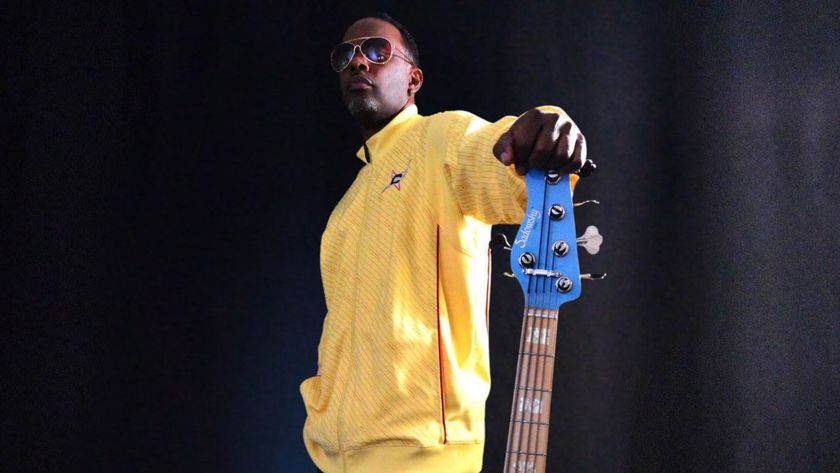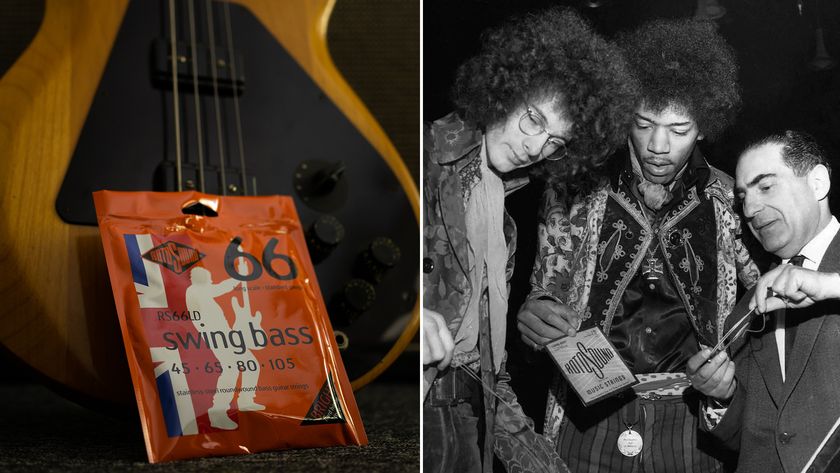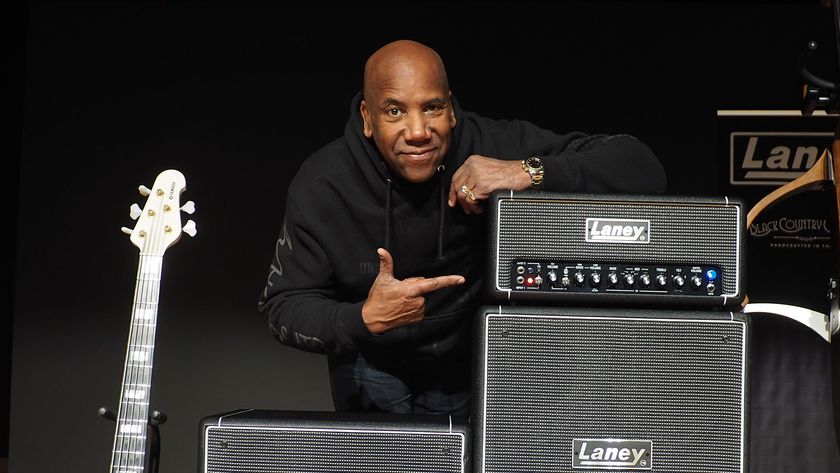Interview and Video: Guitarist Florent Atem Discusses His Slide Picking Technique

For this week's column, I wanted to give some attention to a buddy of mine who is a very promising young guitarist.
His name is Florent Atem from Tahiti. He has a very cool technique that he created called slide picking that he will explain in this interview. Here is a video of Florent playing in this style:
GUITAR WORLD: So Florent how did you come up with this slide picking technique?
Well, as a guitar player, my main focus has always been to find my own voice on the instrument. I had the privilege to study at GIT (Guitar Institute of Technology) at Musician's Institute in Hollywood a while ago, but apart from that, I am mainly self-taught. Besides learning about music theory and what I would call the “tradition” of blues, rock or jazz improvisation, I have always enjoyed trying to push the boundaries of what I could do on my instrument.
That is how I came up with this concept I refer to as “slide picking," which I immediately felt had the potential to be developed into a real, usable and special technique. It consists in sliding the guitar pick across the strings while pressing them against the fretboard to produce notes. It really is the missing link between tapping and sweep picking since it combines their main features in a single motion.
What do you find it to be most useful for?
I have found many different ways to apply this technique to all sorts of scales or arpeggios. It can be particularly useful to perform all kinds of “sequenced” licks. It also makes it incredibly easy to execute phrases that would otherwise be virtually impossible to play and, most importantly, creates a truly unique sound.
Get The Pick Newsletter
All the latest guitar news, interviews, lessons, reviews, deals and more, direct to your inbox!
Run us through the approach you have when playing in this technique.
In standard tuning, sliding the pick from one string to the next -- “vertically,” while staying at the same fret -– will produce the sound of a perfect fourth, except for the second and third strings, which will produce a major third. Now, sliding the pick “diagonally," that is to say while going up or down a fret as you slide from one string to the other, will yield a major third or a flat fifth, which respectively become a minor third and a perfect fourth on the second and third strings.
Combining those basic slide-picking motions makes it possible to stack those intervals on top of each other. Then, pulling off to a fretted note will produce yet another interval. From there, it is quite easy to come up with all sorts of patterns to create all kinds of sounds. Of course, experimenting with altered tunings opens a whole new realm of possibilities.
Any practice tips for anyone out there who might be trying to learn it?
I would recommend getting used to the simplest, most basic slide picking motions, such as a vertical slide on two adjacent strings to begin with, just to get an overall feel. This should be practised in both directions, from low to high and high to low. The fretting-hand might then be added in and it can be very effective to focus on a short sequenced lick until each note really flows evenly.
Proper pick positioning, a firm attack and good fretting-hand muting are the key elements for the notes to ring clearly. Finally, it should be noted that slide picking can also be achieved with the fingernails, the thumbnail being rather suited for descending slides and the others for ascending ones.
What would be your best advice for someone who runs into trouble trying to play this?
As with any other technique, it is very important to practice slowly at first. Slowing things down should enable you to understand what the problem is and what you need to focus on. It might also be a good idea to experiment with different types of picks and find out what works best for you.
You have played shows in Tahiti with Michael Angelo Batio. What was it like jamming and playing with Michael?
Michael was actually the one who prompted me to share this slide picking technique with the guitar world. As we were sound checking before his second Tahiti show in 2009, he noticed an “unusual sound” and asked me what it was. That made me realize I might, perhaps, have something valuable to offer to the guitar community. I am always happy when people are drawn to the very unique sound of this technique and not just the visual, physical move. Performing with Michael is always an amazing experience. He is such an accomplished, unreal player and a dear friend.
Some of my material is available on Amazon, CD Baby or iTunes, most of the places where music can be found online. Beside winning a few awards in Tahiti and Hawaii, I was also fortunate to be nominated twice at the Grammy Awards in the past few years, as part of a Hawaiian “slack key” guitar project. That material is also available online and so are the records I did with my sister, Carole Atem, who is an amazing singer and keyboard player. Finally, my first solo record, titled Dreamtown, is available from M.A.C.E. Music on Michael Angelo Batio’s website. I cut that album at The Plant Studios in Sausalito with John Cuniberti, Jeff Campitelli and Matt Bissonette – who are all well known for their work with Joe Satriani – as well as Michael Manring.
Are you working on any cool projects for the future? A new album, maybe?
I am focusing on live performances and clinics at the moment, but I am still writing new material so there will definitely be a new album, hopefully in a near future.
Who are your biggest influences?
Eric Johnson, Michael Angelo Batio, Joe Satriani, Steve Vai, Nuno Bettencourt and Paul Gilbert have always been among my favorite players. I also really like Pat Martino, Joe Diorio, Wes Montgomery, Allan Holdsworth and Al Di Meola, just to name a few. Apart from guitar players, I have to mention John Coltrane, Dave Weckl, Simon Phillips, Virgil Donati and Peter Gabriel.
Who would make up your dream band, if you could put together a band of anyone, a singer, drummer, the whole thing?
It is virtually impossible for me to narrow down the choices to only a few names but according to my style, but I would say either Simon Phillips or Virgil Donati on drums, Roscoe Beck on bass, David Garfield on keyboards, Peter Gabriel on vocals and Eric Johnson on guitar. I do not really need to be in the band: I would just watch music history in the making.
Dave Reffett is a Berklee College of Music graduate and has worked with some of the best players in rock and metal. He is an instructor at (and the head of) the Hard Rock and Heavy Metal department at The Real School of Music in the metro Boston area. He also is a master clinician and a highly-in-demand private guitar teacher. He teaches lessons in person and worldwide via Skype. As an artist and performer, he is working on some soon-to-be revealed high-profile projects with A-list players in rock and metal. In 2009, he formed the musical project Shredding The Envelope and released the critically acclaimed album The Call Of The Flames. Dave also is an official artist endorsee for companies like Seymour Duncan, Gibson, Eminence and Esoterik Guitars, which in 2011 released a Dave Reffett signature model guitar, the DR-1. Dave has worked in the past at Sanctuary Records and Virgin Records, where he promoting acts like The Rolling Stones, Janet Jackson, Korn and Meat Loaf.
Dave Reffett headshot photo by Yolanda Sutherland







“I nicked some cymbals, the bass player’s amp head and some microphones. I got Bowie’s microphone with his lipstick on it!” On July 3, 1973, David Bowie retired Ziggy Stardust – that same day, Steve Jones stole his equipment

“Jeff was playing through his dodgy Marshall and didn’t like the sound. He said, ‘We’ll do it again, later on…’” Mick Rogers may be in possession of Jeff Beck’s last-ever studio recording










